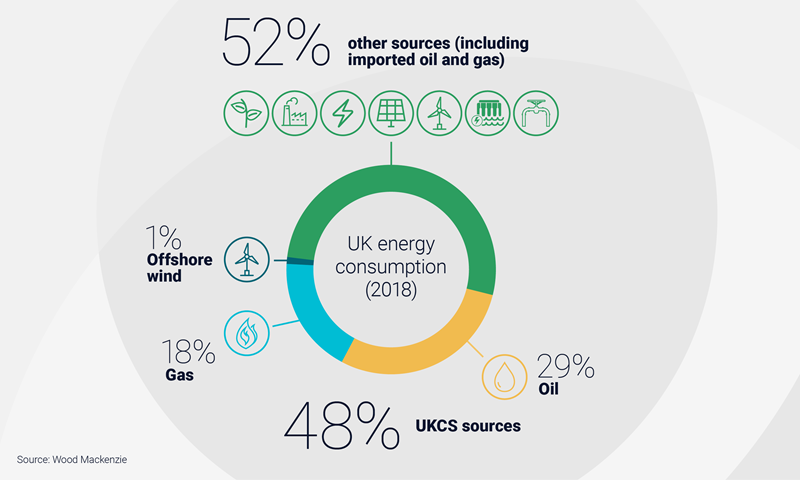
Plotting a course to a net zero North Sea
The UK Continental Shelf (UKCS) is evolving to harness the full power of the offshore environment. A new study from Wood Mackenzie and the Oil and Gas Technology Centre (OGTC) explores the economic opportunity and lays out the technology roadmap to a carbon neutral future.
Download an extract from Closing the Gap: Technology for a Net Zero UKCS
For the last 50 years the North Sea has been synonymous with oil and gas. But ambitious net zero targets have brought the vast renewable energy and carbon offsetting potential of the entire UKCS environment into sharp focus.
What is the UKCS net zero vision?
The UKCS is at the heart of the UK economy. That won’t change – but the energy ecosystem will. The UKCS will evolve into a decarbonised, integrated energy system. One that can optimise the offshore sector’s economic value and deliver a secure supply of affordable energy.
This transition will harness the unique qualities of the UKCS – world-class oil and gas and renewables sectors, with abundant natural resources, connected to substantial domestic and international markets. The natural depletion of the oil and gas sector over time will be more than offset by the growth in offshore renewables, hydrogen and carbon capture, utilisation and storage (CCUS).
Our research shows that developing low carbon technology industries could more than double the economic impact of the UKCS, contributing £2.5 trillion to the UK economy and creating more than 200,000 new jobs. But realising this UKCS integrated energy vision will require investment of £430 billion by 2050.
Swipe the bar on the map below to see how the picture could change.
What’s driving the pace of change?
Oil and gas currently meets nearly half of the UK’s total energy demand. The industry is both a feature of everyday life and a major contributor to climate change.
In 2018 the UK produced 451 million tonnes CO2 equivalent (MtCO2e) of greenhouse gas emissions. Around 3% of this total is direct emissions (scope 1) from oil and gas activity on the UKCS. Energy generation, mainly from fossil fuels, produced 23% of emissions, and the transport industry accounted for a further 28%, mostly from the use of oil-based products.
In May 2019 the Committee on Climate Change (CCC) recommended that the UK should legislate as soon as possible to reach net zero emissions. As a result, the Climate Change Act was amended in June 2019 – making the UK the first major economy to pass a net zero emissions law. The Scottish Parliament also passed its own Climate Change Act, targeting net zero by 2045, as recommended by the CCC. And in June 2020 the UK’s offshore oil and gas industry committed to achieving net zero production by 2050.
All of these targets require a radical change to the way energy and resources are produced and consumed. And this change must gather pace.
How will net zero be achieved – and how much progress has been made?
The OGTC has commissioned a major new study to highlight the technologies that will be instrumental in achieving a net zero UKCS – and the innovation gaps that must be closed.
Watch this short film for an introduction to our report: Closing the Gap: Technology for a Net Zero UKCS.
Fill in the form at the top of this page for an extract that includes:
- Foreword from Colette Cohen OBE, CEO of The OGTC
- Executive summary
- Sizing up the UKCS on the road to net zero.
Closing the Gap – Technology for a Net Zero UKCS: exploring the report
Over the coming weeks, we’ll bring you a series of articles on the current status of the decarbonisation of the UKCS – and the roadmap to a net zero future.
Part one: offshore renewables
The UK is currently the world leader in offshore wind. At the end of 2019, the UKCS had an installed capacity of 8.6GW – more than any other country. In 2020, offshore wind is expected to generate 10% of the UK's electricity. 20 projects are currently planned or under construction that will contribute an additional 19GW of capacity over the next 10 years.
The CCC targets 75GW of offshore wind capacity by 2050. Is the sector on track? What innovation gaps and challenges could stand in the way? What role will other offshore renewables play in the evolution of the UKCS?
Read part one: Offshore wind propels the UK’s net zero ambitions.
Part 2: hydrogen
Hydrogen can be used in place of gas to heat homes, power engines and industrial processes, whilst reducing our carbon footprint. The CCC has set significant targets for a low-carbon hydrogen economy in the UK, but production remains close to non-existent. What technology challenges must be overcome before hydrogen can be deployed on a commercial scale? And how big is the opportunity if hydrogen lives up to its potential?
Read part two: Can hydrogen live up to its hype?
Part 3: CCUS
CCUS plays a critical role in supporting the emissions reduction of hard to abate industrial sectors and in the production of blue hydrogen. The UKCS has significant storage potential and the UK is well-positioned to develop a CCUS industry. Expansion is unlikely to be held back by technological hurdles – but what are the barriers to growth? And how can they be overcome?
Read part three: Can the UK lead the world in carbon capture, utilisation and storage?
Part 4: oil and gas
UKCS oil and gas operators are already taking steps to reduce carbon emissions. They’re improving operational efficiency, deploying low-carbon technologies to power operations and developing next-generation methods to unlock lower emission barrels. But where are the innovation gaps? And how much additional investment is needed?
Read part four: Is net zero oil and gas production possible?
Part 5: economic impact of a net zero UKCS
Investment in net zero technologies and the development of an integrated energy system has the potential to generate £36 billion in revenue in 2050. That’s more than double the total revenue generated across these industries today. What’s the total direct and indirect economic impact between now and 2050? How many jobs would be created in industries, technologies and services that support the transition? What are the risks and uncertainties? How much capital investment is required to tap into this potential – and where should it be focused?
Read part five: A £2.5 trillion transformation
Hear from our experts
In this episode of the Europe in Brief podcast, we discuss how the UKCS can contribute to the UK's commitment to achieve net zero by 2050.
What will the decarbonisation of the UKCS mean for you?
Realising a net zero vision of the North Sea is both a technological challenge and a huge opportunity. What could it mean for your business?
Talk to an expert to find out more.

Malcolm Forbes-Cable, Vice President, Upstream Consulting and Supply Chain Lead
Explore our latest thinking
Loading...
